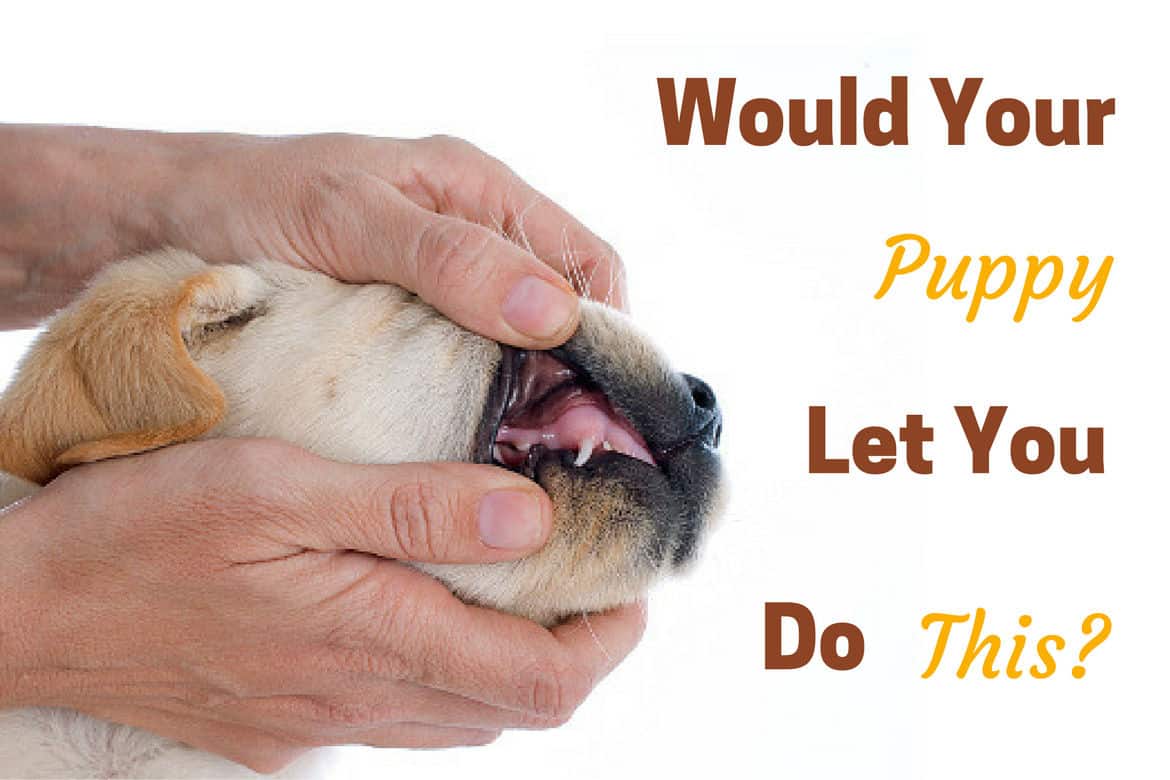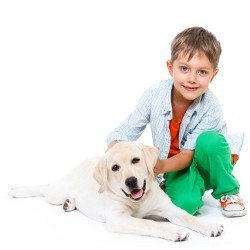This post may contain affiliate links. We may earn money or products from the companies mentioned in this post.

Whether you’ve just gotten a new puppy or adopted an adult dog, it’s very important to make sure they can accept handling.
Most people get dogs for their companionship and this simply won’t be possible with a pooch who doesn’t like to be touched.
It’s common for all breeds of dogs to become stressed when handled by strangers, but with the proper training you can minimize this problem.
With a bit of patience, it can be fairly simple to train your Lab to accept handling.
Just remember that the training process will be easier if you start when your Labrador is still a puppy if possible. If working with an adult rescue, then extra patience, time and rewards will be needed.
Why It’s Important For Your Dog To Accept Handling
Your Labrador’s ability to accept handling is more important than simply letting you cuddle with them. It’s also a matter of safety, especially around children and strangers.
Safety With Children
Young children tend to play fairly rough with their dogs, pulling on them or even just hugging them constantly.
If your pooch doesn’t accept handling, they may become aggressive or turn into a fear biter when this happens, injuring your child.
Please note, that children should be taught to respect your dog’s space as well and you mustn’t leave them alone together, they should always be supervised.
Safety With Tactile, Touchy Strangers
Accepting handling will also allow strangers to pet your dog when you take them for a walk and help them cope if they are brushed against when walking on a crowded street.
So You Can Groom And Inspect Them
Additionally, consider all the things you need to do to keep your dog healthy and what they include.
Brushing out undercoat requires handling your Lab, and if they aren’t comfortable with this, they may be difficult to control or become stressed.
This goes for bathing, rubbing in shampoo and conditioner, after they swim or roll in something nasty too.
So The Vet Can Handle Them
The vet will also need to handle your dog during regular checkups.
While it’s true that vets have the necessary training and experience to work with aggressive or fearful dogs, one who meets this description may have to be sedated or restrained during physical exams.
This will further stress your pet and put both them and the vet at risk for injury.
In extreme cases, if your Labrador fiercely rejects being handled, they may even need to be anesthetized for these simple tasks. That will add a significant amount of money to your vet bill and put your dog at risk.
Having a well-adjusted dog is a pleasure and easy to take with you to the park, family picnics and other fun outings. A dog who isn’t used to being handled can be dangerous and doesn’t live a full, happy life.
Things You Should Be Able To Do and Why
When training your Labrador puppy to accept handling, you want to make sure they calmly accept you touching them in specific ways.
Each of these serves a particular purpose, from making trips to the vet easier to letting you perform regular grooming and allowing strangers to approach or pet your dog.
Touch Your Dog’s back, Tummy and Head
Your first goal should be for your lab to be fine with having a hand run over their back, tummy, and head.
These are the most commonly petted areas, so accepting handling there is the minimum for a good companion.
These areas are also checked by your vet at every visit, and important for grooming.
This means if your pooch can accept hands running on their back, tummy, or head, they should be okay with a basic examination at the vet.
Also, aim to get your dog comfortable with scratching through their fur.
This will help with grooming and let you (or the vet) check for injuries. Searching through the fur is essential for removing undercoat during grooming in addition to ticks or fleas.
Touch Your Dog’s Legs And Paws
Another important area of the body where you should be able to touch your dog is their legs and paws.
You want to be able to feel down the legs and between the toes, as you will need to when grooming or when checking for injuries.
This will also be useful when trips outside take them through muddy areas so you can remove mud or thorns.
Furthermore, being comfortable with touches to their nails is also crucial so the groomer can easily trim them.
Your puppy or dog should also accept having their legs lifted one at a time as this is useful for grooming, training or checking for injuries.
Touch Your Dog’s Mouth, Eyes And Ears
Finally, you want to be able to handle your puppy’s mouth, eyes, and ears.
They need to be fine with having their mouth opened to look at their teeth and with having the gums pressed.
This is necessary for brushing their teeth at home, giving them medications, and removing anything that may get stuck between their teeth.
You need to be able to touch their ears to clean them, as well as look into their eyes and touch the surrounding area in case they need eye drops or to clean tear stains.
Be sure that you can lift and gently pull your lab’s tail upwards, which is necessary for emptying the anal sacs when grooming.
Accepting this handling is even more important if you send your dog to a professional groomer, or someone they don’t know for this process.
How To Train A Puppy To Accept Handling

As soon as you get your new puppy, make an effort to hold and touch them everywhere several times a day. Have every member of the family do this and encourage guests to touch them as well.
Many people will focus on the most-commonly petted areas, such as the back, tummy, or head. Pay attention to areas such as the ears, paws and tail as they are often missed and very important for health checks and grooming.
If you don’t handle these areas while your dog is still a puppy, they may become defensive when touched there as an adult and certainly won’t be comfortable with it.
During the training process, try using food as a treat or reward in addition to giving them praise.
Take a handful of their normal kibble and use as a treat or use specific training treats. Simply touch or examine an area and when they are good, give them a reward.
Step By Step Guide For New Puppies
The general steps for training a new puppy to be handled require repetition, reward and consistency.
Again, it is important to remember the least touched areas. These include the collar area, paws, ears, mouth, and tail.
- Gently touch the given area.
- Praise your puppy right away and give them a treat.
- Repeat this process several times.
- Follow the above steps, but holding the areas for a longer amount of time. Massage gently so your pet enjoys it and keep the conditioning positive.
- If your pup squirms while being touched, such as while holding their ear, maintain your grip until they calm down and then reward them. Use a hand on the collar for support so you aren’t negatively reinforcing your Lab by accidentally pulling their ear or tail.
- For each area, start by getting your pup used to handling on the exterior before working on the inside. (Example: Have them get used to you touching the outside of their mouth, then the side, then lifting their lips to expose teeth, and finally to touching teeth).
Extra Considerations For Older Dogs
It can be much more challenging to train an adult Labrador to accept handling, especially a rescue who may have been abused. The most important thing to remember is to be patient and not to force anything.
Start slowly, with a small area that you know your dog likes (or doesn’t mind) having touched. Then work with them to expand the areas they accept being handled, going at their pace and not forcing things.
For instance, start at the base of the ear where they are accustomed to being touched and work your way out to the tips.
If you have an older dog, don’t wait until a grooming or vet appointment; try to train them to accept handling as soon as you can for a better experience. Keep training sessions short and upbeat.
Overcoming Common Problems
Perhaps the most common problem when training a Labrador to accept handling is having them struggle and resist.
If this happens, don’t give in and release them as they will learn that gets them what they want!
Instead, hold your Lab so their legs point away and they are low enough down where they can’t turn to bite. Keep them there until they calm down, then praise and release them.
If you move too fast and your dog seems uncomfortable or defensive with an area you are touching, don’t be afraid to take a step backwards.
Give them a bit of room and then wait for them to come up to you and try the training exercise again, with the help of some treats.
In cases where your dog or puppy becomes truly aggressive during training, consult an expert in dog behavior and/or training.
They will help you get over the major hurdles until your Labrador is at a point where you can safely continue training them yourself.
Conclusion
As discussed, you will need to train your Labrador puppy or dog to accept handling. This is essential for them to live a normal life and it allows you to groom them and take them for trips to the vet.
It’s best to start teaching your lab to accept touches early on as puppies are more adaptive than older dogs, but it can still be done with adults as long as you follow the correct technique.
Follow the basic steps in this guide and be sure to work on every part of your pup. You want them to be comfortable being touched on every part of their body in case the need arises in an emergency and to help with general grooming.
Disclaimer
All content on this site is provided for informational and entertainment purposes only. It is not intended to be nor can it be considered actionable professional advice. It must not be used as an alternative for seeking professional advice from a veterinarian or other certified professional.
LabradorTrainingHQ.com assumes no responsibility or liability for the use or misuse of what’s written on this site. Please consult a professional before taking any course of action with any medical, health or behavioral related issue.
Top Picks For Our Dogs
- BEST PUPPY TOY
We Like: Calmeroos Puppy Toy w/ Heartbeat and Heat Packs - Perfect for new puppies. Helps ease anxiety in their new home. - BEST DOG CHEW
We Like: Bones & Chews Bully Sticks - All of our puppies love to bite, nip, and chew. We love using Bully Sticks to help divert these unwanted behaviors. - BEST DOG TREATS
We Like: Crazy Dog Train Me Treats - One of our favorite treats for training our service dog puppies. - BEST FRESH DOG FOOD
We Like: The Farmer's Dog - A couple months ago we started feeding Raven fresh dog food and she loves it! Get 50% off your first order of The Farmer's Dog.
For a list of all the supplies we get for our new service dog puppies check out our New Puppy Checklist on the PuppyInTraining.com blog.